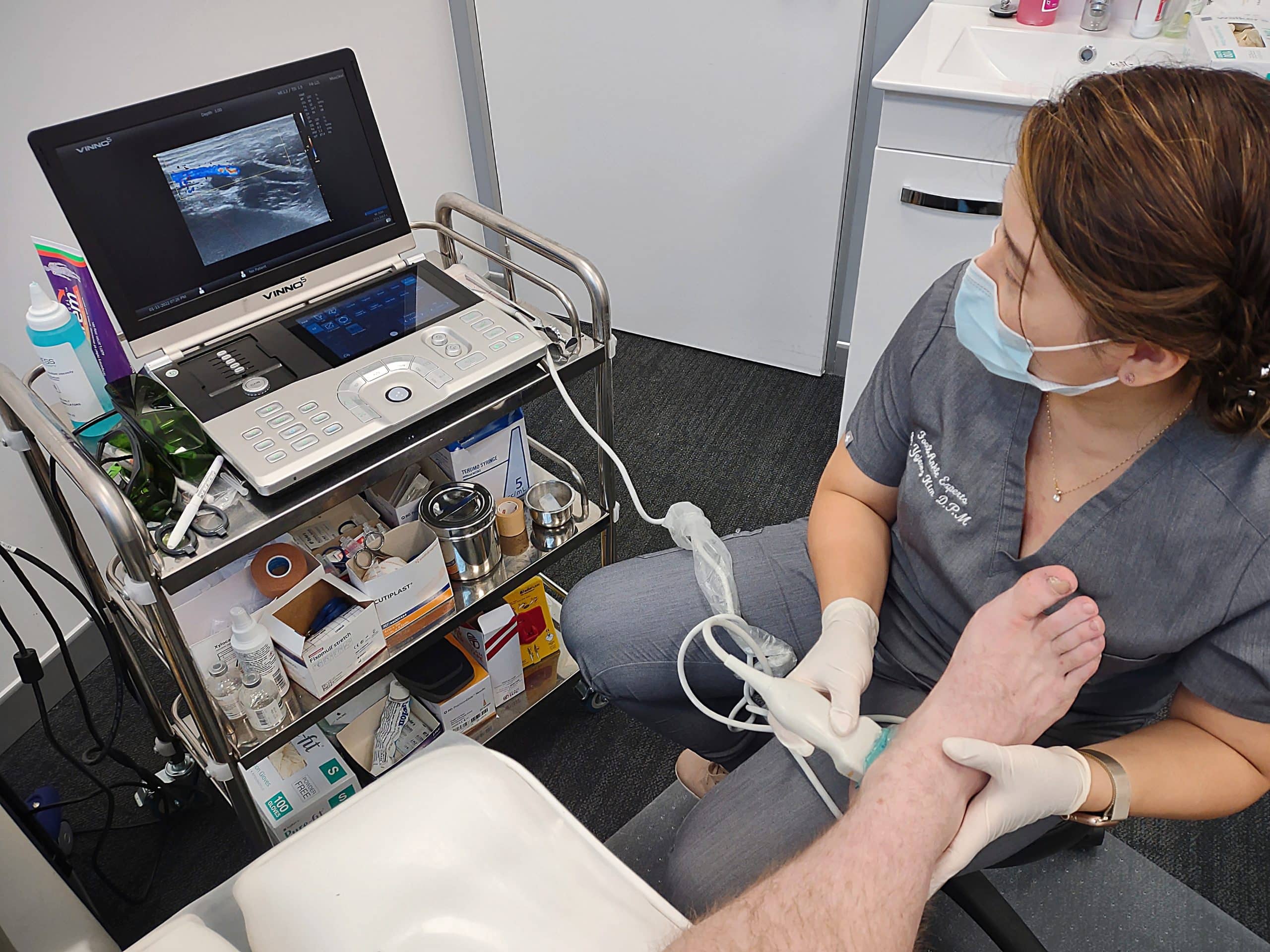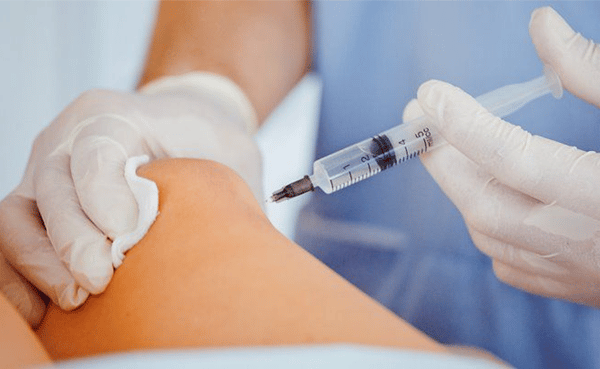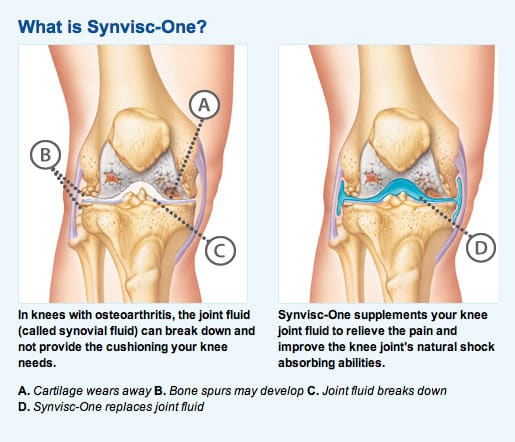At the Foot & Ankle Experts Health clinic, we’re dedicated to easing your lower limb pain with personalised care. Our team taps into cutting-edge injection treatments like ACP, Synvisc, and Prolotherapy to tackle everything from knee osteoarthritis to plantar fasciitis. We harness your body’s natural healing powers to mend tissues, soothe pain, and get you back on your feet with improved function.
Pain Relieving Injection Therapies
Ultrasound Guided
Dr. Kim performs all injections with the help of the diagnostic ultrasound, making the process safer and more precise. This technique allows Dr. Kim to avoid sensitive areas, choose the most comfortable injection spots, and make sure the treatment is applied exactly where it’s needed.
It also means there’s less chance of infection and other complications. Plus, patients can watch the ultrasound screen and see what’s happening, which helps them understand and feel more at ease during the treatment.

What is Prolotherapy?
Prolotherapy is a pain relief procedure that helps to reinforce weakened tendons and ligaments. By injecting a solution, usually with dextrose, it creates a mild inflammation that encourages the body to heal itself, potentially strengthening tissues and reducing pain. The exact way prolotherapy works isn’t fully understood, but it’s intended to make weak areas firmer and less painful.
This treatment can be applied in two main ways: one targets nerves near the skin surface to quickly ease pain, and the other goes deeper into inflamed tissues, depending on what’s needed for the patient. Generally, prolotherapy is safe, with a low risk of side effects or infections. It often takes a few sessions to get the best results, but many people start to feel better after just a couple of treatments.
What conditions can be helped with Prolotherapy Injections?
Prolotherapy is often considered as a treatment option for chronic musculoskeletal conditions, such as:
- Ligament and Tendon Injuries: Including injuries in the knee, ankle, and other joints.
- Osteoarthritis: Especially in joints with mild to moderate degeneration.
- Chronic Low Back Pain: Due to ligament laxity or instability.
- Sports Injuries: To promote the healing of soft tissue injuries.

What is Autologous Conditioned Plasma
Autologous Conditioned Plasma (ACP), is a medical treatment derived from a patient’s own blood. It involves a process in which a small amount of the patient’s blood is drawn, typically from the arm, and then processed to concentrate the platelets, growth factors, and other healing components present in the blood plasma.
The key steps in the ACP process are as follows:
- Blood Collection: A healthcare provider collects a small sample of the patient’s blood, usually through a standard blood draw.
- Centrifugation: The blood sample is placed in a centrifuge, which is a machine that spins at high speed to separate its components. This process separates the platelets and growth factors from other blood components.
- Autologous Conditioned Plasma (ACP) Concentration: After centrifugation, the concentrated platelets and growth factors, along with a portion of the plasma, are collected to form Autologous Conditioned Plasma (ACP).
- Injection: The concentrated ACP is then injected back into the patient’s body at the site of the injury or condition being treated. This injection delivers a high concentration of growth factors and platelets directly to the targeted area, promoting tissue healing and regeneration.

What conditions can be helped with Autologous Conditioned Plasma?
Autologous Conditioned Plasma (ACP), can be beneficial for a range of lower limb conditions and injuries. These treatments aim to promote tissue healing and reduce pain and inflammation in the lower extremities. Some of the lower limb conditions that can potentially be helped with ACP therapy include:
- Knee Osteoarthritis: ACP injections into the knee joint can help reduce pain and improve joint function in individuals with knee osteoarthritis.
- Tendonitis: ACP may be used to treat various forms of tendonitis in the lower limbs, such as Achilles tendonitis, patellar tendonitis (jumper’s knee), and hamstring tendonitis.
- Plantar Fasciitis: ACP injections can be beneficial for individuals with plantar fasciitis, a common cause of heel pain.
- Ankle Sprains and Ligament Injuries: ACP therapy can aid in the healing of ankle sprains and injuries to the ligaments of the ankle joint.
- Tendinopathy: Conditions like patellar tendinopathy (often seen in athletes) and Achilles tendinopathy may benefit from ACP/PRP treatments to promote tendon healing.
- Stress Fractures: In some cases, ACP therapy may be considered to support the healing of stress fractures in the lower limb bones.
- Arthritis: For some individuals with arthritis in the lower limb joints, ACP injections may help alleviate pain and improve joint function.
- Chronic Pain: ACP therapy can be used as part of a comprehensive treatment plan for chronic lower limb pain, especially when conservative treatments have not provided sufficient relief.
It’s important to note that the effectiveness of ACP therapy can vary among individuals, and not everyone may experience the same degree of improvement. The decision to use ACP should be made in consultation with a healthcare provider who can assess the specific condition and determine the most appropriate treatment plan.
What is Hyaluronic Acid (Synvisc)?
Hyaluronic acid, is a gel-like substance injected into joints to ease osteoarthritis pain for up to six months. This treatment, particularly with Synvisc-One, mimics the body’s own joint lubricant and can significantly improve mobility in affected lower limb joints, offering a cushioning effect that resembles the fluid found in healthy joints. The procedure is quick and done in the clinic, allowing for a swift return to everyday activities, though it’s advised to avoid heavy exercise for a couple of days post-injection.
Most patients find relief from joint pain with Synvisc-One within a month after treatment, and the benefits can last for half a year. While the injection is generally well-tolerated, some might experience temporary joint pain and swelling, treatable with anti-inflammatory drugs. It’s important to note that people with allergies to bird products need to consult with their doctor, as this treatment may not be suitable for them.

What conditions can be helped with Hyaluronic Acid (Synvisc)?
Hyaluronic Acid, such as the brand Synvisc, is primarily used to treat osteoarthritis, a common degenerative joint condition that results in pain, stiffness, and reduced joint function. Specifically, it is commonly used to address osteoarthritis in weight-bearing joints, particularly in the knee joint. However, its effectiveness may vary from person to person.
Conditions that can be helped with Hyaluronic Acid (Synvisc) treatment include:
- Osteoarthritis (OA): Synvisc is most commonly used to manage the symptoms of knee osteoarthritis. It can help reduce pain, improve joint mobility, and enhance overall joint function.
- Ankle Osteoarthritis: In some cases, Synvisc injections may be used to alleviate pain and improve function in individuals with ankle osteoarthritis.

